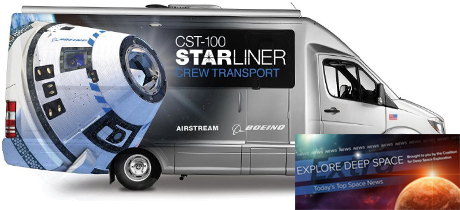In Today’s Deep Space Extra… In a sign of the times, established and entrepreneurial space companies — Blue Origin, Lockheed Martin, Northrop Grumman and Draper Laboratory — have teamed to complete to provide NASA with a commercial human Moon lander. Nanoracks to demonstrate a technology for converting second stage rocket bodies into human habitats.
Human Space Exploration
Woerner optimistic about ESA’s upcoming ministerial meeting
SpaceNews.com (10/23): Jan Woerner, director general of the European Space Agency (ESA), expressed optimism on Wednesday that ESA’s 22 member states will agree to most if not all of the funding needed to support the agency’s priorities, including participation in NASA led initiatives to return human explorers to the surface of the Moon in 2024 to establish a sustained presence and prepare for expeditions to Mars. Woerner spoke from Washington D.C., as a participant in the 70th International Astronautical Congress (IAC). The members will consider a $13.9 billion (U.S.) commitment over three years.
Boeing and Airstream show off their new astronaut transport vehicle: the Astrovan II
Coalition Member in the News – Boeing
Universe Today (10/23): A new van developed by Airsteam for Boeing will transport astronauts from their crew quarters to the launch pad on Florida’s space coast as they prepare to liftoff for the International Space Station (ISS). They call the van Airstream 2. Boeing is partnered with NASA’s Commercial Crew Program to develop a means of transporting astronauts to and from the Space Station and other future low Earth orbit destinations.
Jeff Bezos’ Blue Origin to partner with 3 companies on NASA Moon lander
Coalition Members in the News – Lockheed Martin, Northrop Grumman
New York Times (10/22): Amazon billionaire Jeff Bezos and his Blue Origin space startup will partner with Lockheed Martin, Northrop Grumman and Draper Laboratory to develop a commercial lander to shuttle astronauts between NASA’s orbiting, human tended Gateway and the surface of the Moon. NASA is hosting a commercial competition. The Blue Origin effort is to pair the best of the old with the new to lower costs and accelerate the effort. “The inflow of dollars not just from billionaires, but also venture capitalists and institutional investors has altered the space industry,” said Mary Lynne Dittmar, executive director of the Coalition for Deep Space Exploration, told the Times.
(More from Dr. Dittmar, https://twitter.com/DittmarML/status/1187013270114320384?s=20)
50 years after NASA discarded the wet workshop, a company aims to revive it
Coalition Member in the News – Nanoracks
Ars Technica (10/23): A commercial alliance led by Houston based Nanoracks is focused on reviving a space habitat concept in which large rocket upper stages could be recycled once in space to fabricate more cost efficient living quarters for astronauts working in low Earth orbit or bound for the Moon, Mars and other deep space destinations. Late in 2020, Nanoracks plans to launch a mission to demonstrate how rocket upper stage materials could be cut. Three metal samples will be launched on a platform with a robot arm and milling device. The 30 to 60 minutes experiment will be imaged and the transmissions sent back to Earth.
Nanoracks to launch test on way to manufacturing in space
Coalition Member in the News – Nanoracks
Houston Chronicle (10/23): Houston based Nanoracks, a leader in introducing commercial activities to the International Space Station (ISS), announced plans this week to sponsor the first ever launch and demonstration of a technology to cut metal in low Earth orbit. It’s a potentially enabling technology for the conversion of launch vehicle second stages into human habitats for commercial activities in Earth orbit or habitats developed to support long term human missions to Mars.
Space Science
Israel plans to go back to the Moon and stick the landing this time
Space.com (10/23): Israel’s Beresheet Moon lander mission had a disappointing ending in June due to a computer issue that prevented a soft landing on the Moon. SpaceIL, the organization behind the mission, intends to take its lessons learned and try again within the next 2 to 2 1/2 years, this time with an on board hazard avoidance sensor, according to a presentation before the 70th International Astronautical Congress (IAC) in Washington D.C. this week.
NASA’s planet-hunting probe joins the search for intelligent aliens
Space.com (10/23): NASA’s Transiting Exoplanet Survey Satellite (TESS) was launched in April 2018 to survey the nearest stars for evidence of Earth like planets. Now TESS mission participants will collaborate with Breakthrough Listen project to help focus it search for tech signatures, broadcast signals and other evidence that may indicate the presence of intelligent life on those worlds.
Other News
Luxembourg extends space resources work through new agreements with NASA and ESA
SpaceNews.com (10/23): The Luxembourg Space Agency, an advocate for the exploration of space resources, has reached agreements with NASA and the European Space Agency (ESA), according to an announcement coming from the 70th International Astronautical Congress (IAC). Luxembourg is in the process of establishing a Space Resources Research Center to further its space mining pursuits. NASA is among global space agencies and commercial investors interested in identifying and mining resources from planetary bodies, including the Moon and asteroids.

